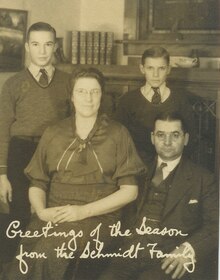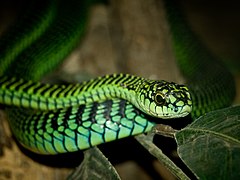Karl Patterson Schmidt
Karl Patterson Schmidt | |
|---|---|
| Born | June 19, 1890 Lake Forest, Illinois, U.S. |
| Died | September 26, 1957 (aged 67) Chicago, Illinois, U.S. |
| Cause of death | Snakebite |
| Citizenship | American |
| Alma mater | Lake Forest Academy, Cornell University |
| Spouse |
Margaret Wightman (m. 1919) |
| Children | 2 |
| Awards | Animal geographies |
| Institutions | American Museum of Natural History, Field Museum of Natural History |
| Notable students | Robert F. Inger |
| Author abbrev. (zoology) | K. P. Schmidt |
Karl Patterson Schmidt (June 19, 1890 – September 26, 1957) was an American
Family
Schmidt was the son of George W. Schmidt and Margaret Patterson Schmidt. George W. Schmidt was a German professor, who, at the time of Karl Schmidt's birth, was teaching in Lake Forest, Illinois. His family left the city in 1907 and settled in Wisconsin. They worked on a farm near Stanley, Wisconsin,[2] where his mother and his younger brother died in a fire on August 7, 1935. The brother, Franklin J. W. Schmidt, had been prominent in the then-new field of wildlife management.[3] Karl Schmidt married Margaret Wightman in 1919, and they had two sons, John and Robert.[4]

Education
In 1913, Schmidt entered Cornell University to study biology and geology. In 1915, he discovered his preference for herpetology during a four-month training course at the Perdee Oil Company in Louisiana. In 1916, he received the degree of Bachelor of Arts and made his first geological expedition to Santo Domingo. In 1952 he was awarded an honorary Doctor of Science degree by Earlham College.[4]
Career
From 1916 to 1922, he worked as scientific assistant in
Death
On September 26, 1957, Schmidt was accidentally bitten by a juvenile
Later that evening, Schmidt felt slightly ill. By the next morning, the lethal effects of the venom rapidly became evident. He did not report to work, and at noon, he reported to the museum that he was very ill. He soon collapsed at his home in Homewood, Illinois, bleeding in his lungs, kidneys, heart, and brain, and was dead on arrival at Ingalls Memorial Hospital.[7][8] Following the bite, he took detailed notes on the symptoms that he experienced, almost until death.[9] Schmidt was asked just a few hours before he died if he wanted medical care, but he refused because it would disrupt the symptoms that he was documenting.[citation needed]
Legacy
Schmidt was one of the most important herpetologists in the 20th century. Though he made only a few important discoveries by himself, he named more than 200 species and was a leading expert on
His writings reveal that he was generally a solid supporter of a
Taxa
Species and subspecies named for Karl Schmidt
Many species and subspecies of amphibians and reptiles[10][11] are named in his honor, including:
- Acanthodactylus schmidti Haas, 1957
- Laurent, 1956)
- Amphisbaena schmidti Gans, 1964
- Aspidoscelis hyperythra schmidti Van Denburgh & Slevin, 1921
- Batrachuperus karlschmidti C.-c. Liu], 1950
- Calamaria schmidti Marx & Inger, 1955
- Coniophanes schmidti Bailey, 1937
- Eleutherodactylus karlschmidti C. Grant, 1931
- Emoia schmidti W. Brown, 1954
- Lerista karlschmidti (Marx & Hosmer, 1959)
- Liolaemus schmidti (Marx, 1960)
- Pseudoxenodon karlschmidti Pope, 1928
- Scincella schmidti Barbour, 1927
- Thrasops schmidti Loveridge, 1936
- Tribolonotus schmidti Burt, 1930
- Urosaurus ornatus schmidti (Mittleman, 1940)
- Varanus karlschmidti Mertens, 1951

Some taxa described by Karl Schmidt
- Batrachuperus tibetanus K.P. Schmidt, 1929[12]
- Eleutherodactylus wightmanaeK.P. Schmidt, 1920
- Varanus albigularis angolensisK.P. Schmidt, 1933
- Leptopelis parvus K.P. Schmidt & Inger, 1959[13]
- Neurergus kaiseri K.P. Schmidt, 1952
Publications
He wrote more than two hundred articles and books, including Living Reptiles of the World, which became an international bestseller.
Books
- 1933 – Amphibians and Reptiles Collected by The Smithsonian Biological Survey of the Panama Canal Zone
- 1934 – Homes and Habits of Wild Animals
- 1938 – Our Friendly Animals and When They Came
- 1941 – Field Book of Snakes of the United States and Canada with Delbert Dwight Davis
- 1949 – Principles of Animal Ecology with Alfred Edwards Emerson
- 1951 – Ecological Animal Geography: An Authorized, Rewritten edition with Warder Clyde Allee, based on Tiergeographie auf oekologischer Grundlage by Richard Hesse. 2nd, John Wiley & Sons, New York
- 1953 – A Check List of North American Amphibians and Reptiles
- 1957 – Living Reptiles of the World with Robert Frederick Inger
Other publications
- Schmidt, Karl P. (1922). The American Alligator. Field Museum of Natural History, Zoology Leaflet No. 3
- Schmidt, Karl P. (1925). "New Reptiles and a New Salamander from China". American Museum Novitates (157): 1–6.[12]
- Schmidt, Karl P.(1929). The Frogs and Toads of the Chicago Area. Field Museum of Natural History, Zoology Leaflet no. 11
- Schmidt, Karl P.(1930). The Salamanders of the Chicago Area. Field Museum of Natural History, Zoology Leaflet no. 12
- Schmidt, Karl P. (1930). "Reptiles of Marshall Field North Arabian desert expeditions, 1927–1928". Field Museum of Natural History Publication 273, Zoological series vol. 17, no. 6., p. 223-230.[14]
- Schmidt, Karl P. (1945) A New Turtle from the Paleocene of Colorado. Fieldiana: Geology, published by the Field Museum of Natural History
- Schmidt, Karl P.; Shannon, F. A. (1947). "Notes on Amphibians and Reptiles of Michoacan, Mexico". Fieldiana Zool. 31: 63–85.[15]
References
- ^ "ESA History/Awards". Ecological Society of America. Archived from the original on May 14, 2008. Retrieved 29 August 2012.
- .
- ^ Leopold, Aldo (1936). "Franklin J. W. Schmidt". Wilson Bulletin. 48 (3): 181–186.
- ^ PMID 17771483.
- JSTOR 1439959.
- ^ "Diary of A Snakebite Death".
- ^ Chicago Daily Tribune. 1957-09-27. p. 1.
- ^ The Field Museum. 11 January 2011. Retrieved 7 August 2012.
- ^ Smith, Charles H. "Chrono-Biographical Sketch: Karl P. Schmidt". Some Biogeographers, Evolutionists and Ecologists. Retrieved 9 September 2014.
- ISBN 978-1-4214-0135-5. ("Karl Schmidt", p. 138; "Schmidt, K.P.", p. 236).
- ^ The Reptile Database. www.reptile-database.org.
- ^ a b Schmidt, Karl P. (February 13, 1925). "New reptiles and a salamander from China" (PDF). American Museum Novitates (157): 1–6. Retrieved 8 August 2012.
- . Retrieved 12 November 2021.
- ^ "Field Museum Library". Archived from the original on 14 April 2013. Retrieved 22 August 2012.
- ^ Schmidt, Karl P.; Shannon, F.A. (Feb 1947). "Notes on amphibians and reptiles of Michoacan, Mexico". Fieldiana: Zoology. 31 (9): 63–85. Retrieved 12 October 2012.
